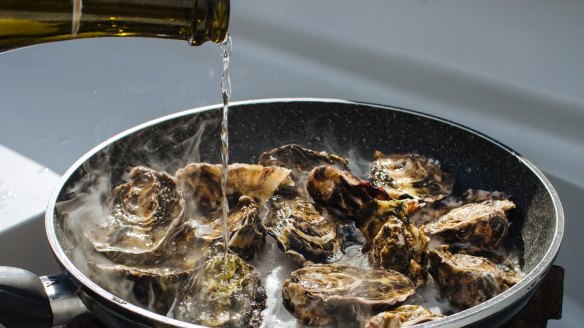Seduced by Tasmanian seafood

The conditions that produce an abundance of truly great seafood aren't a mystery, but bringing them together in one place at the right time is anything but ordinary.
You need the right geography; cold water conditions for slow, patient growth, light to keep the land and water rich in nutrients, sheltered areas to attract different species, and proximity to a continental shelf for biodiversity. You need help from human history, too; not so many people so the water stays clean, but enough of the right kind to care for its preservation so it isn't spoiled by pollution or overfishing.
Out on the D'Entrecasteaux Channel that runs between Bruny Island and the southeastern Tasmanian mainland, it's clear that these things have come together for Tasmania all at the right time.
I'm touring by boat on Pennicott Wilderness Journeys' Tasmanian Seafood Seduction cruise, and although we're only minutes from Hobart's city centre the water is clean and uncommonly clear. Tasmanian seafood has always been exquisite, and there's an awful lot of it. This island produces just about all of Australia's local salmon, and Australians are eating more of that than ever before.
The Tasmanian fish of choice, however, is the Striped Trumpeter, a rich and firm-fleshed white fish that many Tasmanians consider the best eating in the ocean. Heading out on your boat (or that of a friend) to haul in your own seafood is a favourite distraction down here and ironically, it's that very pastime that not so long ago made it hard for visitors to really get amongst it.
The old adage of trying to sell ice to Inuits comes to mind, and finding Tasmania's best seafood while on dry land once meant cooking it yourself. Abalone wasn't considered especially gourmet, sea urchin certainly not so, and few Tasmanians were willing to pay top dollar for lobster in a restaurant when they could just walk down to the water and grab one themselves. Outside of a few higher-end Chinese establishments in Hobart with live tanks, Tasmanian seafood was usually either cooked on a barbecue with some mates, or battered, deep-fried and wrapped with chips in brown paper (though you won't hear any complaints about any of that from me).
These days, however, finding fresh seafood is a much simpler process. There are lots of restaurants that place Tasmanian seafood front and centre. Dropping into Franklin, perhaps Hobart's best known fine-diner, I saw a fisherman pull his boat trailer up right outside the restaurant door and new head chef Annaliese Gregory carting fish directly from the deck into the kitchen.
Turning up to a great restaurant is one way to do it, but my seafood tour with Pennicott Wilderness Journeys takes a different approach. It recreates for visitors that local Tasmanian experience of a day out on a boat, for a moveable on-water feast.
We start with oysters from Bruny Island's Get Shucked that are plump and creamy with the mineral tang of being pulled fresh from the sea. We have them natural and lightly steamed in Tasmanian sparkling wine. Passing by some of the Channel's ubiquitous salmon farms we have salmon belly sashimi, cut fresh and served with soy sauce and wasabi. Sadly not the locally grown Tasmanian wasabi, but the star of this show is certainly the fish itself.
A few coves on and we've stopped for lobster. A live Southern rock lobster is dispatched humanely and prepared both as sashimi and lightly poached in seawater. The simple pleasure of cooking a crustacean in the water it was caught in, is truly as good as seafood gets.
From there, things are even more interesting as I'm invited to take part in gathering, preparing and cooking. It's a treat not normally extended to guests, but in my case they've made an exception. My hosts dive for abalone and sea urchin. I get in the water too, but licensing restrictions mean I'm just observing while they gather the final course. On deck, the abalone is sliced and quickly fried in butter and the sea urchin cleaned and eaten immediately, the large orange "tongues" buttery and sweet with a glass of Tasmanian riesling.
I get to cook as well, throwing together a few on-hand ingredients to steam a whole cleaned abalone in salt and sake, and topping it with lobster meat fried in brown butter. It's stupidly decadent, but in the context of a day-long seafood meal it seems fitting.
If you've ever wondered if you can have too much of a good thing, I can confidently tell you from hard experience that when it comes to Tasmanian seafood the answer is no, you cannot.
Create your own Tassie story: gobehindthescenery.com.au
This article brought to you by Tourism Tasmania.
Restaurant reviews, news and the hottest openings served to your inbox.
Sign up